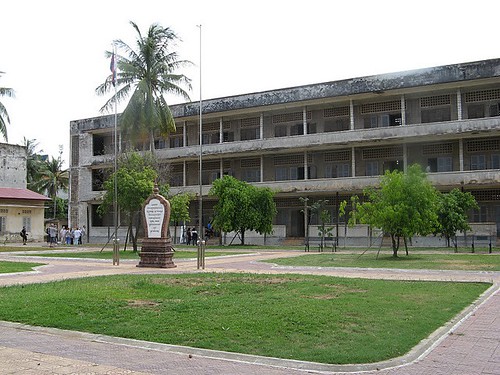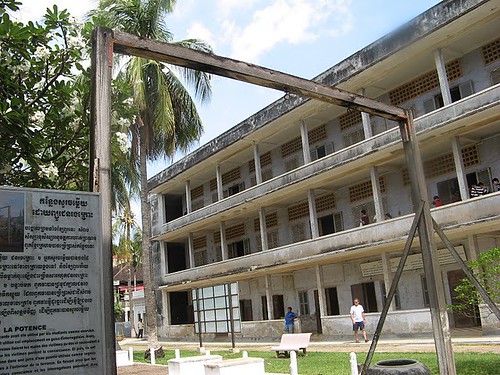The S.21 prison and museum was also called the Tuol Sleng Prison. It is the Cambodian Genocide Museum. It was once the Public School 21 Building under French rule but after prohibition of education by the Khmer Rouge, it was changed to the 'confession and torture' centre for those who were accused of betrayal against Angka, the political organization of the Khmer Rouge. The prisoners who were arrested were tortured most inhumanly. After the prisoner confessed, he was executed and his body was dumped into mass graves which were later known as The Killing Fields (at Choeung Ek ). The Tuol Sleng Genocide Museum is the memorial as well as a building that testifies the horrific crime of Khmer Rouge Regime.
The most famous of what have become known as Cambodia’s 'killing fields' (there are about 300 of them), Choeung Ek consists of a field of roughly excavated mass graves and an open memorial tower filled with thousands of human bones. While there are many similar memorial sites throughout Cambodia,
Choeung Ek is unusual in that has become a tourism destination.
Located about 15 kilometres outside of Phnom Penh, Choeung Ek is closely linked to the S.21 detention centre. Most of the prisoners who were held captive at S.21 were taken to the Choeung Ek killing field where they were bludgeoned to death and the bodies dumped in one of the approximately 129 mass graves. It is estimated that the graves contain the remains of over 20,000 victims. The Vietnamese discovered the site in 1979.
Choeung Ek is a large site, about the size of a soccer field, and is surrounded by farmland. At the centre of the site a 62-metre high concrete and plexiglas stupa displays over 5,000 human skulls. Behind the stupa visitors can walk freely around a series of partially exhumed mass graves in which over 20,000 victims were buried, both local and foreigners, in 129 mass graves. When it rains heavily shards of human bones and scraps of the clothing worn by the victims sometimes surface in the walkways around the graves.
The day I visited the site it was raining a little (the site staff lent me an umbrella to go round the site) though not a dull day. The site instructions ask that the visitor pay respects to the spirit of the victims by walking around quietly. With the weather and the atmosphere in the place I cannot see how anyone could not be quiet. It was really overpowering with most of the pits and other areas marked with a placard on a post to indicate what had happened there. The one thing that made me shiver was to see the tree where the children had been killed. This had a lot of memorial ribbons on it and the starkness of the notice board was hard to believe. It hit home without any doubt. Maybe that was the idea of putting it there because the imagination did more than seeing the site and the skulls. I was given an audio player to go around with and besides describing what went on in each marked place it had recordings from people who had been tortured, and in one case, from an officer who worked in the S.21 prison. A visit I will never forget.

 |
| S.21 School |
 |
| The 'exercise' bar |
 |
 |
One of the cells with the iron bed and shackles used to hold the prisoners. The Vietcong certainly knew how to use the shackles in very inventive ways. The scene above was similar in every room in the building. Where there were cells the prisoners were chained to shackles bolted into the floor.
|
Located about 15 kilometres outside of Phnom Penh, Choeung Ek is closely linked to the S.21 detention centre. Most of the prisoners who were held captive at S.21 were taken to the Choeung Ek killing field where they were bludgeoned to death and the bodies dumped in one of the approximately 129 mass graves. It is estimated that the graves contain the remains of over 20,000 victims. The Vietnamese discovered the site in 1979.
Choeung Ek is a large site, about the size of a soccer field, and is surrounded by farmland. At the centre of the site a 62-metre high concrete and plexiglas stupa displays over 5,000 human skulls. Behind the stupa visitors can walk freely around a series of partially exhumed mass graves in which over 20,000 victims were buried, both local and foreigners, in 129 mass graves. When it rains heavily shards of human bones and scraps of the clothing worn by the victims sometimes surface in the walkways around the graves.
The day I visited the site it was raining a little (the site staff lent me an umbrella to go round the site) though not a dull day. The site instructions ask that the visitor pay respects to the spirit of the victims by walking around quietly. With the weather and the atmosphere in the place I cannot see how anyone could not be quiet. It was really overpowering with most of the pits and other areas marked with a placard on a post to indicate what had happened there. The one thing that made me shiver was to see the tree where the children had been killed. This had a lot of memorial ribbons on it and the starkness of the notice board was hard to believe. It hit home without any doubt. Maybe that was the idea of putting it there because the imagination did more than seeing the site and the skulls. I was given an audio player to go around with and besides describing what went on in each marked place it had recordings from people who had been tortured, and in one case, from an officer who worked in the S.21 prison. A visit I will never forget.
 |
| The central stupa |
 |
| Scenes about the killing fields |
 |
 |
 |
 |


No comments:
Post a Comment